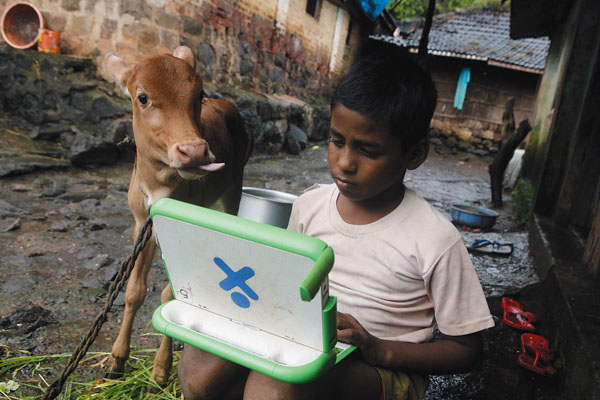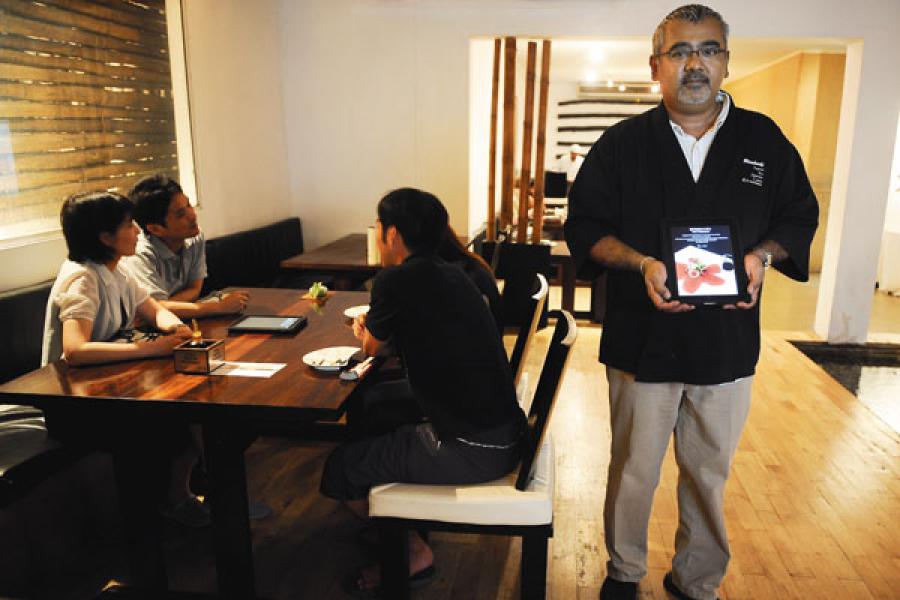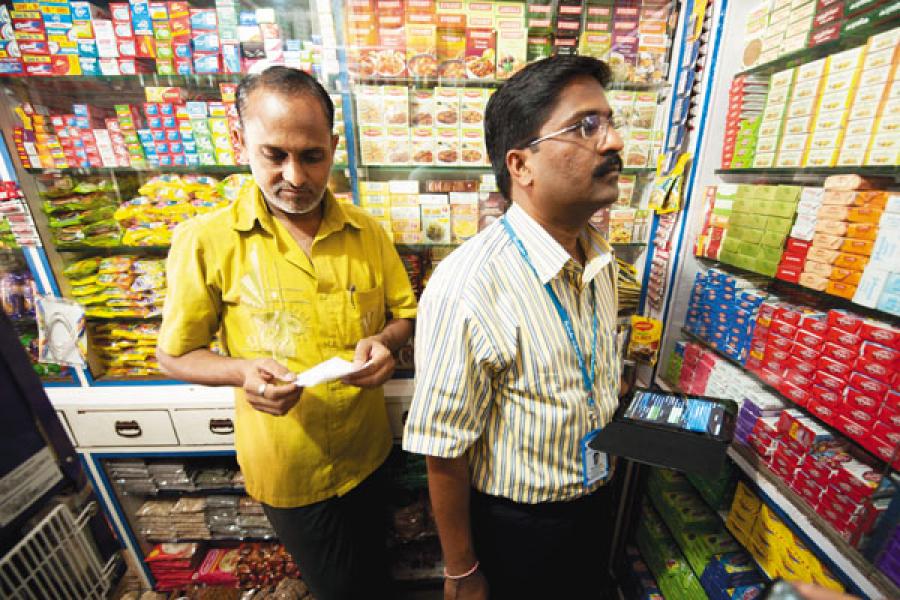
How Businesses Are Tapping Tablets
Three businesses and how they are tapping tablets to extend their reach and provide better services
1 RESTAURANT AT THE END OF THE INDIAN OCEAN — ALMOST!
WHO: Dharshan Munidasa, 40 years old, owner of fine dining Japanese restaurant Nihonbashi in Colombo, Sri Lanka.
PRELUDE: His is one of the first restaurants in the world to adopt the tablet. He has two iPads for his 80 table cover restaurant.
WHY HE IS TAKING A TABLET: Munidasa uses the iPad’s high-quality display to showcase custom dishes that patrons may not have encountered anywhere. “Sushi, people know. But they have no idea what a ‘NoName Sashimi’ made out of SeaDream fish means. I use the iPad for that,” he says. He has put his entire wine list on the iPad. People find it easier to order a bottle because it has a picture of their favourite label. He has also put up advertisements of hotels such as Conrad at Rangali and Six Senses at Sonevagili. He is a restaurant advisor to these hotels. Munidasa believes that patrons who come to Nihonbashi can be directed to these hotels through these advertisements.
FUTURE: A wine list filtering app. This will allow people to put in their preferences and budgets to get a customised wine list.
WHAT HE WON’T DO: Hook up the iPad to his billing system. He doesn’t want a situation where “someone presses a button and first the food arrives on the table, later the bill”. This, he believes, destroys the connection that patrons have with the restaurant staff when they choose and eat food. “Food is about communication. When you like it you express it, as you do when you don’t like the food. That process mustn’t be subverted.”
2 THE MEDICINE MAN
WHO: Nandkishor Dhomne, 40 years old, CIO of Manipal Health Enterprises
PRELUDE: One of the first hospitals in the country to have a tablet rollout plan clearly chalked out, Manipal Hospital is moving towards seamless services for patients — from the ward, ICU, operation theatre and pathology labs even when doctors are on the move.
WHY HE IS TAKING A TABLET: Manipal wants to automate data entry and transfer, including images, and cut down time lags in service delivery. It plans to:
■ Place tablets at each nursing station and move them around when the doctor comes in. Make the tablets RFID-enabled and provide patients too with RFID bands which will allow flow of information between the patient and device and eliminate data entry errors. It will also allow doctors to order tests at the bedside and even record patient conversation or take photos of the wound if necessary, for further consultation.
■ When doctors are on the move they can be alerted about emergencies on their handheld devices and when they rush to the patient, vital information can be instantly accessed on the tablet.
■ It wants to speed up patient discharge which often gets delayed if the doctor isn’t around. The idea is to provide reports on the tablet and let the doctor sign off digitally.
■ It wants to capture instant patient feedback.
FUTURE: Once the implementation is complete in the Bangalore hospital, with 25-40 tablets, it will take it to other locations.
WHAT HE WON’T DO: Hook up the hospital’s billing and pharmacy section to the tablet. These are location-specific services which need to be delivered in person, and in real time. “You don’t want your medicines or bills to come from someone sitting in the canteen,” says Dhomne.
3 THE CONSUMER GOODS GIANT’S LITTLE HELPER
WHO: Hemant Bakshi, 44 years old, Hindustan Unilever’s executive director, sales and customer development.
PRELUDE: Bakshi has taken something very good and made it better. HUL’s legendary distribution machinery is now present in villages with a population of just 5,000 people.
WHY HE IS TAKING A TABLET: HUL wants all the 1.5 million outlets that sell its products to be ‘perfect stores’. A store is ‘perfect’ when any product, any pack size that the customer asks for, is available. HUL is running a pilot with 25 Samsung Galaxy Tabs to help the company sales representatives do the following:
■ Access information on sales trends in every pack size in the outlets and sales that each distributor salesperson is making. This will help in inventory management and improve productivity of the distributor salesperson.
■ Send out information from the market or the feedback of a customer directly from the store in the form of a picture, video or audio file. “Equally, information or communication — example, a new advertising campaign or a new promotion — could be uploaded in real time to the field,” says Bakshi.
■ Do market surveys. The sales representative can access the questionnaire on the tablet and quickly input the
responses using the touch interface.
FUTURE: “We are thinking of extending this to 2,000 company sales representatives if the pilot meets our return on investment criteria. Though we value that which goes beyond return calculations,” says Bakshi.
WHAT HE WON’T DO: With HUL there is no telling what they will do with the tablet, but watching YouTube will perhaps be out of the question!
The Magic Formula
What will it take to crack the India market? A sub-Rs.10,000 tag
by Rohin Dharmakumar & Seema Singh
 Image: Danish Siddiqui/ Reuters
Image: Danish Siddiqui/ Reuters Cat’s whiskers to the world when it comes to IT services or mobile telephony, India has been a basket case when it comes to PCs and Internet penetration. Just 3 percent of Indian homes own a PC and less than 1 percent subscribe to a broadband Internet connection.
Unfortunately, both these aspects are bound together at the hip: Why will consumers buy a PC when Internet connectivity, essential to almost all PC activities today, is spotty and expensive? And why will they get broadband when they don’t even own a PC?
The tablet PC may finally break this riddle — an affordable, reliable and lightweight computing device that comes bundled with either 3G or Wi-Fi wireless connectivity.
India’s ‘magical device’ (that’s the phrase Apple uses to refer to the iPad), will be something like this: Rs. 10,000 in price, built-in wireless access, a 1 GHz-plus non-Intel processor and running Google’s Android operating system.
“I think the sub-Rs. 10,000 tablet is a possibility. We’re right now testing a Huawei tablet that is 50 percent of the cost of a Samsung one, while still offering a good experience,” says Navanit Narayan, Idea Cellular’s head of service delivery. At that price, sales could skyrocket to between 7-10 million tablets per year, says Rahul Sharma, co-founder and COO of Micromax, the largest Indian mobile phone maker.
But even that price can be a challenge in a developing economy. Which is where mobile operator MTS, which is launching its own branded tablet in a few months, is attempting to copy a Western trick: Subsidised devices.
Leonid Musatov, MTS India’s chief marketing officer, says his company is hoping to replicate with tablets its experience of giving away an HTC smartphone free of cost to customers provided they commit to a longer term relationship.
Unlike the West where tablets are often a ‘post PC’ media consumption device, in India they will be the first computing devices for many families. To facilitate this, some companies are planning to bundle wireless keyboards and mice along with their tablets, turning them almost into full-fledged PCs.
In the next 12-18 months, big mobile operators will also blanket India with 3G coverage. Vineet Taneja, Bharti Airtel’s head of operations for South India, says that the Rs. 10,000 price apart, ubiquitous 3G coverage will be the single biggest factor impacting tablet sales.
(This story appears in the 06 May, 2011 issue of Forbes India. To visit our Archives, click here.)
-
 Umang Saini
Umang SainiThe Sub-10k tablets are already here, Nook (Android based) from B&N, and Kindle (Linux based) from Amazon. However they are targeting book-market first, not generic businesses. They cover education as well but publishers haven't fully embraced it for that segment. Not yet.
on May 3, 2011
















